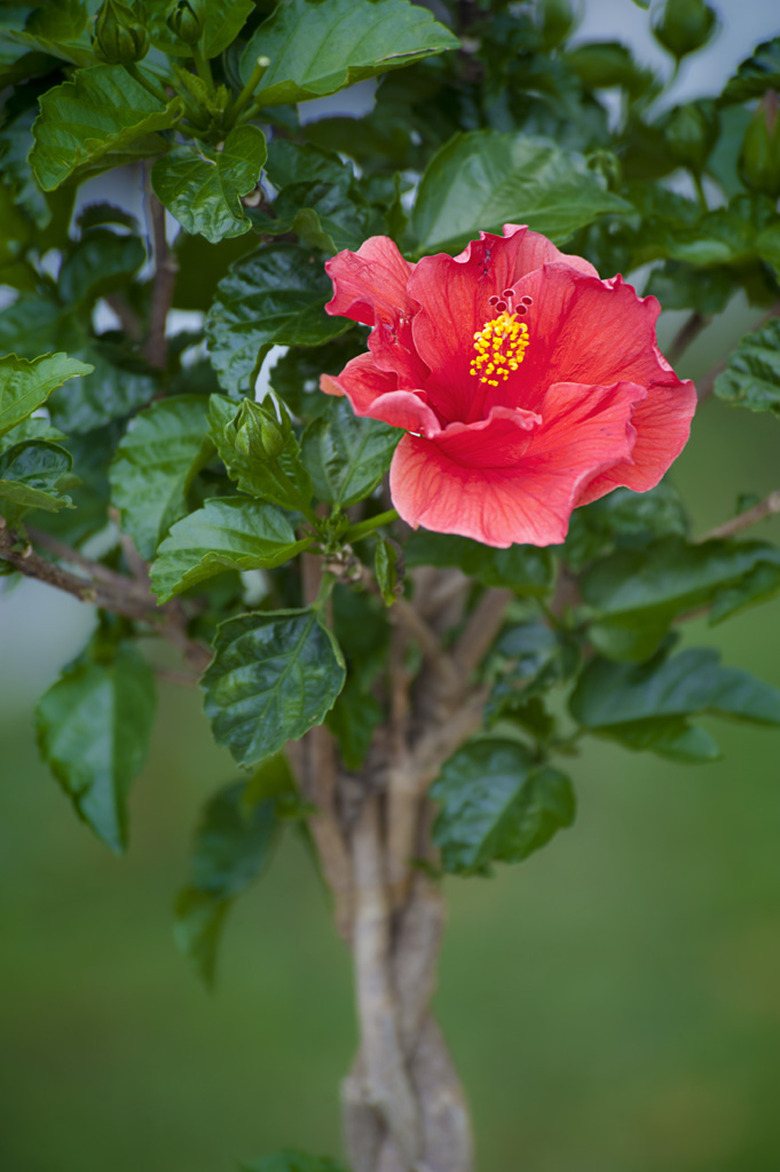Braided Hibiscus Directions And General Care
Drive through any tropical landscape, and you'll see bushes, flowering shrubs, flowering plants and small trees sporting petaled blooms in a variety of colors, shapes and sizes. What you are looking at are just a few of the several hundred species of the hibiscus (Hibiscus spp.) plant.
Hibiscus began with eight species that are the ancestors of the modern hibiscus. Hybridizers have been working for more than 300 years to expand their shape and flower size. Sometimes, they even braid their trunks to create a topiary-like display.
What Hibiscus Species Is Best for Braiding?
The Hibiscus rosa-sinensis, or Chinese hibiscus, is the species of choice if you're considering creating a braided hibiscus tree. In a process that originated in China or India, braiding Chinese hibiscus is the forerunner of the creation of Japanese bonsai.
Braiding them is an art form called shumu penjing. Grown in USDA plant hardiness zones 9 and 10, the Chinese hibiscus plant needs to be braided when young and their stems wrapped together early if they are to reach a height of 5 to 6 feet. At that height, a braided hibiscus is an impressive and dramatic houseplant.
Braiding Potted Hibiscus
1. Choose three to four of the healthiest-looking Chinese hibiscus, the tropical hibiscus variety, you can find. They can vary in hibiscus flower color or all be similar, but keep them under 2 feet tall. 2. The trunks must be as thin as a pencil, and each should have an established root system. 3. Plant the tiny trees in a 10-inch, 3-gallon pot with good drainage and fill it with a soilless potting medium. Add sand and perlite to improve drainage, as hibiscus does not like wet feet. Add organic material such as worm castings once a year. 4. Begin by braiding the trunks together, looping one over the other in a relaxed manner. You want to leave room for the trunks to expand as they grow. Continue braiding until you reach the foliage; then tie the stems together loosely. 5. Trim any straggling stems, making the canopy smooth and uniform. 6. For a hibiscus planted outdoors, the braiding method is the same, but the plant won't survive severe weather conditions. Temperatures below 55°F will surely kill the plant. Overwinter the tree in the house or in a basement. 7. Repot every three years.
Hibiscus Tree Care
It will take several years for your braided hibiscus to reach maturity and become a flowering tree. It will also need attentive maintenance.
- **Sunlight:** Place the pot in a south-facing window
where it gets at least 6 to 8 hours of full sun per day. When the temperatures start to warm, you can acclimatize it to the outdoors by placing the pot in the outdoor sunshine for a few hours daily.
- **Watering:** Overwatering will
kill your plant. Hibiscus prefers being dry. Test the soil by plunging your finger at least 2 inches into the potting mix. If it comes out dry, add water. Fall and winter months require even less water.
- **Fertilizing:** Experts
also suggest that when watering, add a balanced 16-16-16 fertilizer to the water, 1 teaspoon weekly, during the spring.
Tip
Temperatures below 55°F will surely kill the plant. Overwinter the tree in the house or in a basement.
Pruning Your Braided Hibiscus
Pruning hibiscus is akin to giving a young child a haircut. It keeps the plant in a rounded, healthy shape. Trim your tropical hibiscus in the spring, summer and fall.
If your pot is outdoors, bring it in when the temperatures fall and give it a hard prune. Try to prevent the plant from becoming leggy and looking like a sputnik.
Tropical Hibiscus Plant Pests
Whether your braided hibiscus is an outdoor plant or sitting in a sunny spot in the living room, pests will find it. Outdoor hibiscus is more susceptible to pests and disease, but indoor trees also suffer.
If newly emerging buds start to drop, investigate whether the plant has spider mites, thrips, whiteflies or aphids. Overwatering leads to downy or powdery mildew, gray mold or root rot.
Instead of watering weekly, apply a neem soil drench as a replacement for one of those weekly waterings. Its most effective ingredient, Azadirachtin, is dispersed through the whole vascular structure of the hibiscus to destroy the pests.

